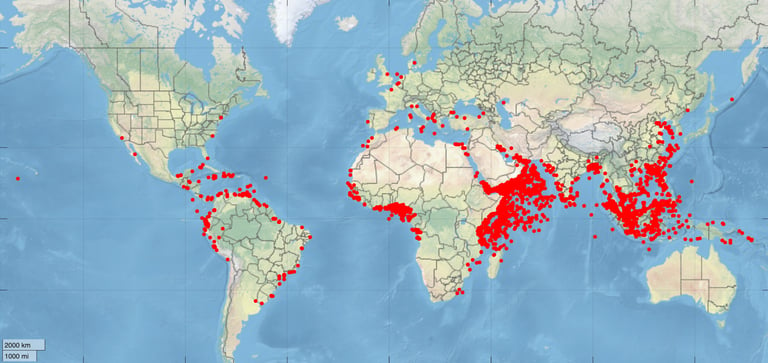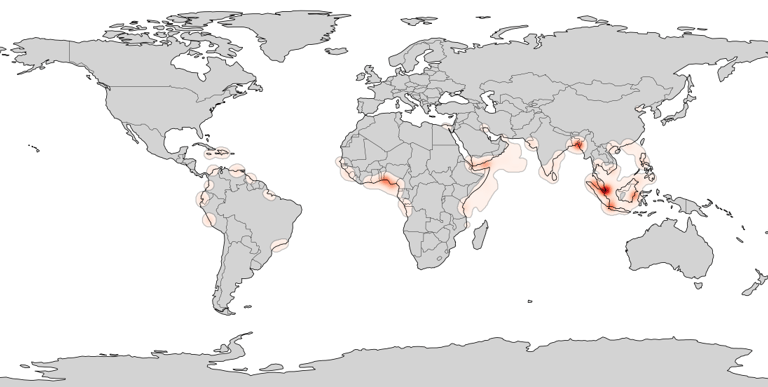Pirates Today: A Cruiser’s Guide to Real Risks and Rogue Waters
How to Stay Safe at Sea
6 min read
When most people hear the word pirates, they imagine a figure from legend - a swaggering sailor with an eye patch, a feathered companion, and a ship lost to time. Something out of fairy tales or Hollywood, not the real world. But pirates are not just relics of the past. They still exist and for bluewater cruisers, they can pose a very real threat.
Some may recall the hijacking of the Maersk Alabama in 2009, a harrowing event that inspired the film Captain Phillips. It wasn’t an isolated incident. In certain regions of the world, piracy continues quietly, dangerously, and far from the spotlight.
In this article, we’ll explore where modern piracy still thrives, how significant the threat really is, and what steps we as sailors can take to stay safe. Set your course. We’re heading into waters where myth meets reality, and awareness could be your best defense.
Definition of Piracy
There’s nothing nostalgic or romantic about piracy. It’s a real and present threat. But before we dive into where and how it happens, it’s important to understand what piracy actually is.
Under international law (UNCLOS Article 101), piracy is defined as any violent or criminal act committed at sea by the crew or passengers of a private vessel, for personal gain, against another ship, its crew, or cargo, and outside any country’s territorial waters. This also includes those who assist in such acts or knowingly operate pirate vessels.
But piracy isn’t the only danger. There's also armed robbery at sea, which happens within a country’s territorial waters, often at anchor or near the coast. Defined by the IMO (Resolution A.1025(26)), it includes any unlawful act of violence, detention, or theft committed for private ends in internal, archipelagic, or territorial waters.
And finally, there's maritime terrorism. It's less common for cruisers, but still a global concern. While there’s no single legal definition, it typically refers to acts of violence or threats against ships, ports, or maritime infrastructure, driven by political or ideological motives, not personal gain.
Where is piracy occurring?
The risk of encountering piracy as a bluewater cruiser depends heavily on where you sail. The level of threat presented by pirates also varies by region. In some areas, incidents may involve nothing more than petty theft or armed robbery, while in others, the danger escalates to hostage-taking and acts of violence.
Fortunately, there are several reliable resources that can help cruisers stay informed:
The ICC Commercial Crime Services maintains the IMB Piracy Reporting Centre, which tracks global piracy incidents. Although the focus is on commercial vessels, the reports give a solid overview of which regions are most dangerous and which are relatively safe.
The Caribbean Safety and Security Net (CSSN) is another excellent tool, especially for sailors in the Caribbean. It collects and shares firsthand reports from cruisers, offering valuable insight into local safety including where it's risky to anchor.
If you want to dig into the data yourself, there's an excellent open-source piracy database covering over 7,000 incidents from 1993 to 2020. Based on the dataset, the maps below show all recorded piracy attacks (left) and the derived hotspots (right). For more recent activity, a live GitHub-based mapping tool visualizes piracy incidents up to the present day with an interactive interface.




Which parts of the world should be sailed with extra caution or avoided?
So, where are modern pirates most active today? By looking at up-to-date piracy maps (linked above) and open data piracy heat maps, we can get a clear sense of the regions to avoid or at least approach with caution. While the global situation continues to shift, certain areas consistently stand out as high-risk zones for cruising vessels:
🔴 Gulf of Aden & Coast of Somalia
These waters are considered high-risk, despite a decline in incidents in recent years. Attacks in this region have included hijackings and hostage situations. For private vessels, transiting this zone without an armed escort or in a convoy is strongly discouraged.
🔴 Gulf of Guinea (West Africa)
This is currently one of the most dangerous areas in the world for piracy. Attacks here are often violent, with a high number involving kidnappings for ransom. Even large commercial ships with security teams are not always safe. For cruisers, it’s a no-go zone.
🟠 Venezuela & Southern Caribbean
This region has seen a notable rise in armed robbery, especially against yachts at anchor. Economic collapse and fuel shortages have driven some local fishermen to target boats for engines, electronics, or provisions. While not every anchorage is dangerous, careful planning and up-to-date reports are essential.
🟡 Strait of Malacca (Malaysia–Indonesia)
A longstanding piracy hotspot due to its busy shipping lanes and narrow passages. Most incidents here involve non-violent theft, and cruisers are rarely targeted. Still, the risk of boarding exists, especially at night or while anchored.
How can you protect yourself?
Even if we carefully avoid high-risk areas, there’s no guarantee that we won’t face an uncomfortable or even dangerous situation. So the question becomes: how can we protect ourselves at sea?
When we talk to people about piracy, one of the first questions is often (maybe because we're living in the U.S.) : “Do you carry a gun?” For us, the answer is no and that’s a conscious choice. Aside from the fact that I personally don’t feel comfortable handling a firearm, I also have serious doubts about whether I could use it in a high-stress moment and whether it would even help. In fact, any weapon on board can potentially be used against you. But beyond that, there’s a much bigger issue: the legal side. Carrying a gun on a cruising boat can become a legal nightmare. In some countries, you’re required to declare and lock up your firearm, which is then sealed by customs and inspected again when you leave. In others, importing weapons is strictly forbidden, even if they never leave the boat. A few countries go further: bringing in a firearm illegally can carry severe penalties including prison time or even the death penalty. So no - for us, arming ourselves with a gun is not worth the risk.
Luckily, there are other ways to reduce risk and improve safety that don’t involve firearms. Some are common sense. Others come from hard-earned experience shared by fellow sailors. Here’s what we’ve learned and are considering:
🔐 Secure the boat
Harden your hatches and companionway: Install extra locks or bars, especially for night passages or anchoring near unstable areas.
Reinforce windows with security film or shutters to make it harder to break in silently.
🌙 Stay invisible at night
If you hear a boat approaching after dark, don’t turn on cabin lights
Have a powerful flashlight or spotlight ready. You want to see them, without letting them clearly see you.
🛡️ Simple but effective deterrents
Keep pepper spray, a baton, or even a baseball bat within reach in the cockpit.
(Emergency flares turned out to be surprisingly ineffective against intruders.)
Consider installing a motion-triggered alarm or pressure sensor mat at entry points - a loud siren can scare off intruders and wakes you up.
A marine air horn is also useful: it can alert others in the anchorage and signal that something’s wrong.
📡 Emergency options
Carry a satellite tracker or emergency beacon (like a Garmin InReach or EPIRB) you can activate in a true crisis.
Some cruisers also prepare a “grab bag” with key documents, a handheld VHF radio, and essentials in case they need to flee or call for help quickly.
The goal isn’t to militarize your boat. The goal is to be prepared, stay calm, and make it as difficult as possible for someone to take advantage of you. Most pirates and thieves aren’t looking for a fight, they want easy targets. Making your boat look alert, secure, and not worth the risk can be your best defense. And finally: don’t isolate yourself. Stay connected to local cruisers’ nets, check recent security reports, and talk to sailors coming the other way. Often, the best information is passed boat-to-boat. Two good videos on piracy were posted by sailing Nahoa on YouTube and can be found here and here.
Final Thoughts
Sailing the world will always come with a few risks but fear shouldn’t be the captain of your journey.
With good planning, solid preparation, and a strong dose of awareness, most dangers can be avoided. Know where you’re going, listen to other sailors, and take smart steps to protect yourself. The ocean is vast and beautiful and yes, sometimes wild and scary. But for those who stay informed and prepared, it’s still one of the most rewarding adventures out there.
If you’d like to read more, follow our journey, and support what we do, don’t forget to subscribe to our newsletter or follow us on social media. Every bit of encouragement helps keep the adventure going and we’d love to have you aboard!
